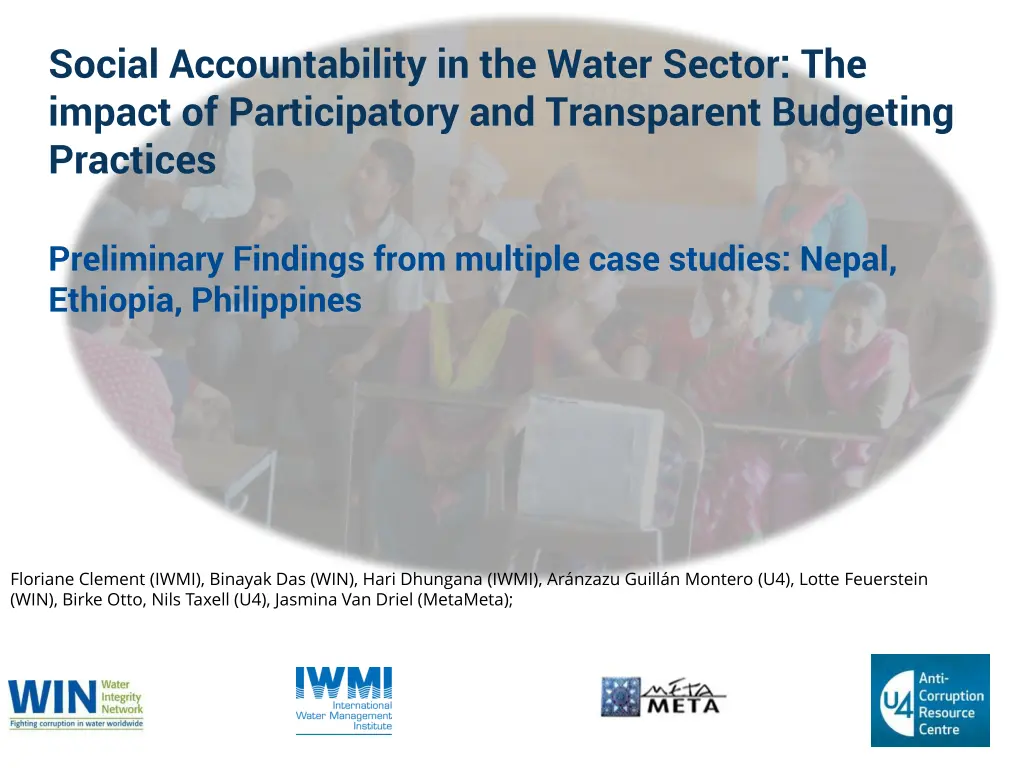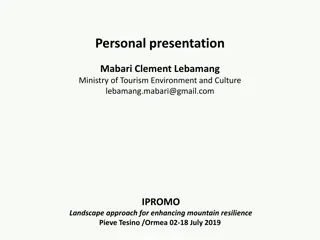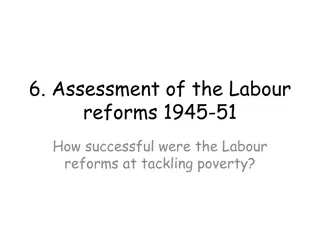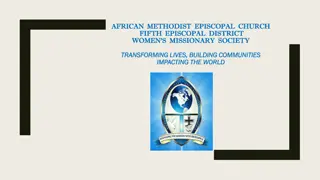
Accountability Practices in Water Sector Analysis
Discover the impact of participatory and transparent budgeting practices on social accountability in the water sector through case studies from Nepal, Ethiopia, and the Philippines. Explore the concept of water integrity, the relationship between social accountability and corruption, and the study's focus on reducing corruption levels in the water sector using participatory and transparent budgeting mechanisms.
Download Presentation

Please find below an Image/Link to download the presentation.
The content on the website is provided AS IS for your information and personal use only. It may not be sold, licensed, or shared on other websites without obtaining consent from the author. If you encounter any issues during the download, it is possible that the publisher has removed the file from their server.
You are allowed to download the files provided on this website for personal or commercial use, subject to the condition that they are used lawfully. All files are the property of their respective owners.
The content on the website is provided AS IS for your information and personal use only. It may not be sold, licensed, or shared on other websites without obtaining consent from the author.
E N D
Presentation Transcript
Social Accountability in the Water Sector: The impact of Participatory and Transparent Budgeting Practices Preliminary Findings from multiple case studies: Nepal, Ethiopia, Philippines Floriane Clement (IWMI), Binayak Das (WIN), Hari Dhungana (IWMI), Ar nzazu Guill n Montero (U4), Lotte Feuerstein (WIN), Birke Otto, Nils Taxell (U4), Jasmina Van Driel (MetaMeta);
Water integrity is the integrity of people and institutions governing water resources. It refers to decision-making that is fair and inclusive, honest and transparent, accountable and free of corruption. Delft Statement, 2013
3 Literature_ Social Accountability and Corruption many individual success stories of SAcc mechanisms, but meta studies have shown mixed results (Rocha Menocal and Sharma, 2008; McGee and Gaventa, 2010; Booth, 2011) impact of social accountability on reducing corruption is generally not the main focus of such studies difficulties to measure results transparency citizen action (voice and participation) accountability government response (answerability and enforceability). BUT: information does not necessarily lead to action; action does not necessarily lead to response (Guillian Monterro, Halloran, Lavin, 2016). need for more nuanced approaches (McGee and Gaventa, 2010); long-term and unanticipated effects (Joshi and Houtzager, 2012) and integration with broader institutional reforms (Fox, 2014; DFID 2015). Corruptionis deviant behavior associated with a particular motivation, namely that of private gain at public expense" (Friedrich, 1989,p. 15)
4 Literature_ Social Accountability, Corruption and Water Few studies on SACc on Water issues E.g. 2007 WEDC synthesis report finds: few social accountability directly focused on the poor, and often require a certain level of education and literacy ; difficult to assess results increased citizen awareness and creation of demands through SACC but state responsiveness and direct impact in terms of service improvement often remains slow and/or is understudied (WaterAid, 2010: 18; see also Butterworth and Potter, 2014, see also Nimanya, 2010 and Fox, 2014) 8/20/2025
5 Aim and Focus of the Study Aim: How do Social Accountability mechanisms contribute to reduced levels of corruption in the water sector and under which conditions? Focus: Participatory and Transparent Budgeting (PTB) PTB is one of the few areas where there is evidence of the positive impact of SACc in specific sectors (e.g. health, education) (e.g. Gon alves, 2013 Cornwall and Shankland, 2008; USAid, 2005), however, evidence and systematic studies for the water sector are scarce. Cases: three similar PTB initiatives in different country contexts in the rural and peri-urban WASH sector. 8/20/2025
6 Research Questions How do the similar PTB initiatives implemented in different contexts differ in terms of implementing agency, approach, process, and outcome (in regard to service delivery, sound financial management, and integrity)? What relationships between the different factors involved can be observed and how do they differ across various country contexts? What is the outcome of the initiatives in regard to (changed) incentives for corrupt practices of power holders? 8/20/2025
Definitions Accountabilityis the process of holding actors responsible for their actions (Fox and Brown, 1998, p. 12). PTBis improving access to and quality of information on local budgets, monitoring public expenditures, informing and educating the public on the budget process, and forming civic groups that participate in the local budgeting process (USAID, 2005).
8 Partners WIN collaboration: Overall study: Collaboration with U4 Anti-corruption Research Centre Nepal case study: Collaboration with IWMI Ethiopia case study: Collaboration with Meta Meta Philippines case study: Collaboration with University of Urios 8/20/2025
9 Study Design Multiple Case Study Analysis/not comparative but raising questions/different cases, similar mechanisms Qualitative methods for three individual cases Interviews, documents and observation In-depth of each case, allows for cross case analysis among selected research dimensions Adapted research protocol for each case 1st observations 8/20/2025
10 Study Design: Case Selection SIBAGAT, PHILIPPINES: the donor-led initiative ETHIOPIA: the government-led initiative NEPAL: the NGO-led initiative PTB approach Budget monitoring via of a Integrity Watch Group at the community level Budget transfer to community ambiguous Sacc mechanism + in some cases coupled with community audits Budget monitoring via public hearings, public reviews and public audits Sector WASH (peri-urban) Irregularities in construction/maintenance &finance/budgeting WASH and irrigation (rural) Spending distortions that resulted in preferential treatment and political bias in budget allocations to regions, zones and woredas (districts) Yes (# of Water Points, # of community water supply beneficiaries, number of latrines, number of ODF Kebeles) 2011-2016 Ministry of Water, Irrigation and Electricity + Regional Water Resources Development Bureaus WASH and irrigation (peri-urban and rural) source disputes and improper use, inappropriate planning and management of water resources; lack of participation Key accountability Problems/ Corruption Risk Area Baseline Data on Service Improvements tbc Yes (enhanced access to improved WSS, e.g. saved water fetching time, improved sanitation conditions) Duration Main Implementing Bodies Launched 2012 Development Organization (UNDP-PACDE) and Government (Department of the Interior and Local Government) Governance and Anti- Corruption Strategy Yes Launched 2001 NGO (Helvetas Nepal) Legal/political context (supply side) Focus on Poor/Marginalised? Ethiopian Social Accountability Project (ESAP) Yes Young democracy, decentralisation reforms Yes Location Sibagat, Philippines Jidda woreda, Oromia national region state, Ethiopia Dailekh and Acham districts, Nepal 8/20/2025
11 Study Design: Research Dimensions Research Dimension (for description and comparison) Types of engagement Descriptions/Questions How do the different initiatives differ in terms of implementing agency, approach and process? Are they tactical projects or strategic programmes? How are service providers and local governments engaged in the initiative and why? How have they responded to expressed demands and changed their practice? Has it stimulated dialogue about corruption and lead citizens to reject corruption? Has it revealed corruption cases? Has it created more possibilities to get caught? Has it reduced spaces for discretion? Are there reduced incidences of inflated budgets, excessive allocations (e.g. training, travel or car purchase)? What is the outcome of the initiative in relation to its stated goals? How has the engagement changed/lasted over time? What other intended and unintended consequences of the initiative can be observed? What is the local context? What is the broader legal- political context? What is complex set of processes and contingencies in which the initiative is embedded? Actions of service providers/local government (Changed) incentives for power holders for corruption Success/sustainability of the initiative Enabling/disabling factors 8/20/2025
12 Case Nepal: Process and Actors Main Actors: Helvetas, Water Resource Management committee, partner NGOS Integrated Water Resource Planning WU Master Plan; public hearing, public review, public audit Types of engagement Actions of service providers/local government 8/20/2025
13 Case Nepal: Observations Use of official language reduces accessibility of information Domination of the chairperson in discussions Local NGO facilitators drive the event Limited dialogue Observation of Public audit 8/20/2025
14 Case Nepal: Analysis key points Cost estimation: mainly mitigated by the process of detailed design from engineers Political capture: lack of political opposition; in small settlements single individuals dominate and are unquestioned by users. Nepotism (no observation of favor to relatives) Procurement: pre-empted by Helvetas providing the materials Wage payment: lack of understanding on wages One case of corruption uncovered: not through the public audits but thanks to the village maintenance worker (changed) Incentives for power holders for corruption Success/sustainabilit y of the initiative Enabling/disabling factors 8/20/2025
15 Nepal Conclusion The SAcc measures enhanced transparency and participation - unclear outcomes on corruption and mismatch between people's expectations on distributive justice (fairness in water distribution) and PTB focus on financial issues. Water Integrity Network - Strategy 2017-2022 Stockholm World Water Week - August 27, 2016
16 Case Ethiopia: Process and Actors Main actors: MoWIE, Regional Bureaus of Water, COWASH, Woreda WASH Team, Kebele WASH team, WASHCO Implementation and maintenance budget for WASH facility managed directly by community committee funds transferred to Regional Micro Finance Institution Ethiopia Social Accountability Programme (ESAP) and One National programme as enabling factors Types of engagement Actions of service providers/local government 8/20/2025
17 Case Ethiopia: Observations Process substantially shorter than conventional government process High transparency in every step data recording and accessibility Higher awareness of rights and duties Authoritarian state and recent emergency situation No incidences of corruption in CMP WASH facilities, although incidences are reported in other projects (changed) incentives for power holders for corruption Enabling/disabling factors 8/20/2025
18 Case Ethiopia: Analysis and Conclusions Clearer ownership of WASH scheme as well as maintenance fund Challenges for the very long run in order for communities to move up the water ladder. More complicated procurement - > CMP approach would be less appropriate Success/sustainability of the initiative Unintended outcomes Although government accountable for capacity building and facilitating process, no direct accountability Challenging to discuss corruption in the Ethiopian setting respondents assured researchers there were no incidents within the CMP facilities 8/20/2025
19 Case Philippines: Process and Actors 1 Municipal Government Unit; 24 Local Government Units (Barangay = villages); 10 Water Cooperatives (2)/Associations (8); 1 Partner NGO IWAG (Integrity Watch) ; Local Government Department, UNDP-PACDE Types of engagement Actions of service providers/local government Program intention is strategic integration of PTB of local water management Cooperatives and the District receiving funds were faced with financial accountability demands by CSO IWAG 8/20/2025
20 Case Philippines: Observation and analysis Program intention is strategic integration of PTB but in fact, implementation shows tactical aspects in resource allocation: (Changed) incentives for power holders for corruption Success/sustai nability of the initiative Enabling/disa bling factors I am willing to give projects but Barangays have to come to me. If you re the first one to come I ll prioritize you. Former Municipal Mayor of Sibagat (during her terms, all 24 Barangays leaders aligned with her party; her successor is a relative.) Program resources appear to be distributed selectively IWAG members are closely related to Municipal or Barangay Governments The municipal government detected overall improved governance, like participation, accountability, etc Overall, the NGO was closely cooperating with municipal officials, at times working on their behalf 8/20/2025
21 Case Philippines: Conclusions The close connection between the CSO and the local government undermines its function to encourage social accountability At the same time, the CSO worked well as capacity development agent on behalf of the local government; created a routine of regular and standardized financial reporting Based on the lacking documentation, the discretion of the municipal government in the selection of beneficiary cooperatives and Barangays appears counter-productive The lack of a program implementation plan and monitoring framework turned the evaluation into an anecdotal exercise 8/20/2025
Recommandations Nepal Accountability needs to be adapted to local context to integrate broader issues of spatial and social justice - expanded beyond project finances and to all project actors Include capacity development to enhance the ability to seek for relevant information and understand it Enhance deliberative competence
23 Recommandations Ethiopia Comparison between 4 implementation modalities in the One WASH National Programme from a SAcc perspective More research into transferring of funding to community; do cash transfers in the Ethiopian context relieve the government of (some of) its accountability towards citizens? Further study at grassroots level: what do communities want with regard to SAcc measures; How are the capacity building initiatives of the CMP structured at community level? 8/20/2025
24 Recommandations Philippines The CSO-based training approach had substantial impact on financial literacy and reporting behaviour Lacking independence of a CSO substantially undermines any mandate to encourage and increase PTB and wider social accountability mechanisms Reporting was poor and is advised as emphasis in future programs: Simple, standardized templates with most basic information Submission to both authorities and program managers Donor documentation needs to improve to learn more about the experience, especially successes and challenges, of such programs 8/20/2025






















